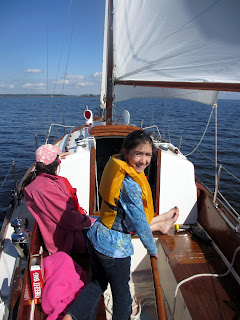This past weekend we enjoyed 8 hours of driving for 40 hours on the boat. A 1:5 ratio. Yet still very worth it and very productive. I may start tracking this ratio if only to satisfy my anal tendencies. Our next trip to the boat should render a 1:10.5 ratio. Lets see how that plan works out.
On the list of what we did get accomplished:
1.) Installed the new fuses for the battery banks and the charger. The battery banks now have 225 Amp fuses on each. It is not really required on the house bank for normal use but if I need to combine the banks for starting if the starter bank is low it needs to be protected. The charger just required a 10 Amp fuse that I had neglected to put in.
2.) With a functioning engine we were able to move the boat to a new slip. The 5 nights we spent in the old slip was pretty rocky with the prevailing winds. That was never going to improve. We were fortunate to be moved relatively quickly after requesting a new slip and were reassigned to the other side of the docks. Luck was not on our side as the wind was coming in from a rare NE direction and blowing 15-20. It made entering this new slip challenging as the correct lines were not in place yet and I still can't get this boat to go backwards. The transmission goes into reverse but the boat just spins in a circle. I had help on the boat and on the dock but it still took 4 attempts. Not pretty.
3.) Installed and adjusted dock lines in new slip.
4.) I installed the new piece of seal-tite for the mast wires where they exit the mast and enter the cabin top. This stuff will not kink and will not leak.
5.) Adjusted dock lines in new slip.
6.) I crimped on new wire ends for the mast head light and anchor light and made all the final connections on the split block. I ran the VHF antennae cable all the way to the radio and installed the final connecting piece. I was not able to solder the shield wires to the housing and I am not getting a strong signal. I will solder properly next time with better equipment. At dusk I checked the mast head light which worked fine but the anchor light appeared to not be working. After a little discussion it was agreed that it is really hard to see the anchor light when standing below it. I went back to the boat to try again with someone on shore with a better angle to see the light. Turns out it was working and working very well. Very Bright. I left it on for a couple of hours to revel in my success until two other people told me I left my anchor light on.
7.) Adjusted dock lines in new slip.
8.) We installed the sampan bimini mounts and poles and strung the old cover across so we could take some measurements. I jacked up the boom as high as it would go and propped it up with a screw driver. I raised the topping lift and figured we had about 8 inches to gain in the height. With the top on we could extend the leading edge, if we installed another support, about 9 inches. I will fabricate the 4 extension pieces and the Admiral can sew a new top. That should get us by for a year or two.
9.) Adjusted dock lines in new slip.
10. I installed the drip tray/support I had fabricated to hold the AC unit in place. The unit fit in perfectly and even though it was cool and windy I ran it for an hour. It took a while for the compressor to come on but did cool down to 66. It was relatively quite and I think will work very well. I just need to add a strap over the top to make sure it stays in place.
11.) Adjusted dock lines in new slip.
12.) We temporarily installed the new bed piece that converts the two settee bunks (parallel) into a twin bed for two (perpendicular). After a nights sleep, some minor refinements were suggested, so the pieces were brought back home to be added too and the foam cover to be made. It will add 6 inches to one side and all will be right with the world....on one side.
13.) Adjusted dock lines in new slip.
14.) Buoyed by the success of this bed piece a template was made for a insert into the v-berth to fill in the void. Construction will be the same and a cushion added to the top. Lots of work to do at home before we head back to the boat in just over two weeks.
15.) And just before we left to come home.....Adjusted dock lines in new slip.

 The girls made it back out in early August for another week of sailing camp with the junior sailor gaining confidence and getting cocky up until the the head and boom made contact. Opti's are great, safe learning platforms.
The girls made it back out in early August for another week of sailing camp with the junior sailor gaining confidence and getting cocky up until the the head and boom made contact. Opti's are great, safe learning platforms.



















































